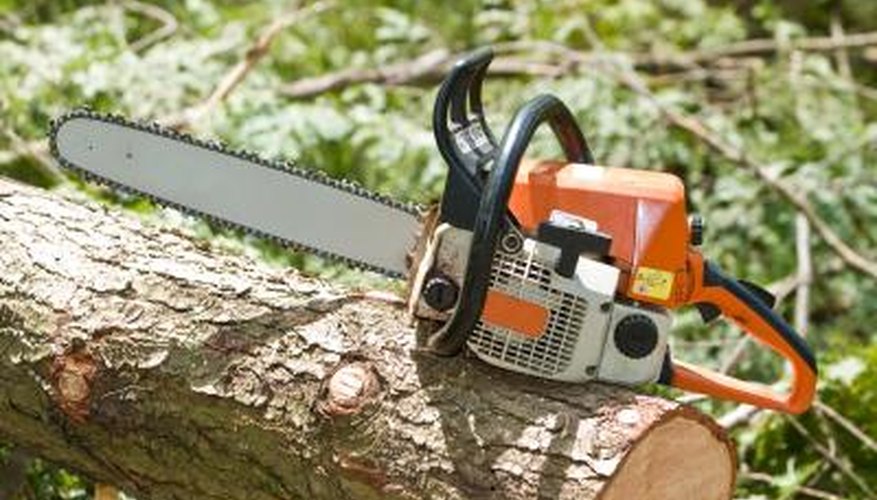The chainsaw can be one of the handiest power tools available. Whether people use them regularly or not, chainsaws frequently misbehave. Chains that stop during a cut can often be freed with only a little troubleshooting and maintenance. For safe and efficient operation, chainsaw owners should check for basic problems and correct them before starting work. Some of the same issues that cause a saw to freeze up could weaken or break the chain.
- The chainsaw can be one of the handiest power tools available.
- Some of the same issues that cause a saw to freeze up could weaken or break the chain.
Push the chainsaw ignition switch, located on the control bar of the grip or in plain sight nearby, to "OFF." Look for a smoking chain or bar, or an overheating engine. If the engine ran normally when the chain stopped, that places the problem either in the bar and chain assembly or the drive.
Push the chain brake -- the shield mounted just in front of the handgrip -- all the way forward. Pull the chain brake back again to release the chain and eliminate this as a possible problem. Never run a saw above idle speed with the chain brake on for longer than three seconds, according to the Stihl instruction manual.
- Push the chain brake -- the shield mounted just in front of the handgrip -- all the way forward.
- Never run a saw above idle speed with the chain brake on for longer than three seconds, according to the Stihl instruction manual.
Grasp the saw chain on the top of the bar just in front of the engine and pull the chain forward carefully. Wear thick leather gloves when checking a chain, to prevent cuts and burns. A properly tensioned saw chain moves smoothly, but if lifted and released snaps back into place like a fiddle string. Chains set too tight overheat, and slack chains wear out the bar.
Check the bar and chain for oil. A chainsaw lubricates the chain as it moves. If the bar and chain dry out, the bar burns and the links freeze.
- Check the bar and chain for oil.
Remove the cap from the bar oil tank and check the oil level. Refill this if needed. Fill the bar oil tank every time you fill the gas tank -- the oil tank never runs dry if you follow this procedure faithfully. A dry oil tank means a burnt bar and chain, as the Craftsman Poulan Pro manual states.
Check beneath the plate that bolts the chainsaw bar to the engine housing for sawdust clogs. Fine wood powder jammed beneath this cover prevents oil from reaching the bar. Powdery sawdust also indicates a dull saw chain.
Loosen the two hex nuts on the cover that shields the base of the saw bar and the drive gear. Remove the cover and clean the assembly beneath it thoroughly to make sure oil flows to the bar.
Replace the cover and tighten the hex nuts finger tight. Locate the tension adjustment screw just inside the bar cover. Lift the saw bar and tighten the saw chain with the flat screwdriver blade of the saw wrench. Tighten both hex nuts with the saw wrench and check chain tension again. Repeat until the tightened chain runs smoothly without slack.
- Check beneath the plate that bolts the chainsaw bar to the engine housing for sawdust clogs.
- Locate the tension adjustment screw just inside the bar cover.
Follow the starting procedure for your brand and model of saw. With chain brake off, rev the engine to check for chain movement. Hold the saw blade over a clear patch of ground and run the saw for about 10 seconds. The moving chain should throw a visible streak of bar oil on the ground.
TIP
When both engine and chain slow to a halt, the trouble may lie in the engine. Carburettor settings, clogged air filters or fouled spark arresters could all cause this problem. Overheating a chainsaw engine might cause the piston to score the cylinder and freeze -- marking the end of the saw's useful lifetime.
WARNING
Never pull on a saw chain against the cutting edges of the teeth. Always test chains by pulling in the safe direction -- the same way the teeth point.
